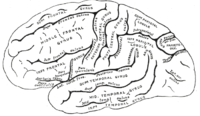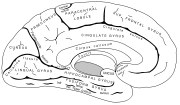
Sulcus (neuroanatomy)
Encyclopedia


Neuroanatomy
Neuroanatomy is the study of the anatomy and organization of the nervous system. In contrast to animals with radial symmetry, whose nervous system consists of a distributed network of cells, animals with bilateral symmetry have segregated, defined nervous systems, and thus we can begin to speak of...
, a sulcus (Latin
Latin
Latin is an Italic language originally spoken in Latium and Ancient Rome. It, along with most European languages, is a descendant of the ancient Proto-Indo-European language. Although it is considered a dead language, a number of scholars and members of the Christian clergy speak it fluently, and...
: "furrow", pl. sulci) is a depression or fissure in the surface of the brain.
It surrounds the gyri
Gyrus
A gyrus is a ridge on the cerebral cortex. It is generally surrounded by one or more sulci .-Notable gyri:* Superior frontal gyrus, lat. gyrus frontalis superior* Middle frontal gyrus, lat. gyrus frontalis medius...
, creating the characteristic appearance of the brain
Brain
The brain is the center of the nervous system in all vertebrate and most invertebrate animals—only a few primitive invertebrates such as sponges, jellyfish, sea squirts and starfishes do not have one. It is located in the head, usually close to primary sensory apparatus such as vision, hearing,...
in human
Human
Humans are the only living species in the Homo genus...
s and other large mammal
Mammal
Mammals are members of a class of air-breathing vertebrate animals characterised by the possession of endothermy, hair, three middle ear bones, and mammary glands functional in mothers with young...
s.
Large furrows (sulci) that divide the brain into lobes
Lobe (anatomy)
In anatomy, a lobe is a clear anatomical division or extension that can be determined without the use of a microscope This is in contrast to a lobule, which is a clear division only visible histologically....
are often called fissures. The large furrow that divides the two hemispheres—the interhemispheric fissure
Medial longitudinal fissure
The great longitudinal fissure is the deep groove which separates the two hemispheres of the vertebrate brain....
—is very rarely called a "sulcus".
Individual variation
The sulcal pattern varies between human individuals, and the most elaborate overview on this variation is probably an atlas by Ono, Kubick and Abernathey: Atlas of the Cerebral Sulci.Some of the larger sulci are, however, seen across individuals - and even species - so it is possible to establish a nomenclature.
Gyrification across species
The variation in the amount of fissures in the brain (gyrification) between species is related to the size of the animal and the size of the brain. Mammals that have smooth-surfaced or nonconvoluted brains are called lissencephalics and those that have folded or convoluted brains gyrencephalics. The division between the two groups occurs when cortical surface area is about 10 cm2 and the brain has a volume of 3–4 cm3. Large rodents such as beavers (40 pounds (18.1 kg)) and capybaras (150 pounds (68 kg)) are gyrencephalic and smaller rodents such as rats and mice lissencephalic.Brain development
In humans, cerebral convolutions appear at about 5 months and take at least into the first year after birth to fully develop. It has been found that the width of cortical sulci not only increases with age , but also with cognitive decline in the elderly.Notable sulci
- Calcarine sulcus
- Central sulcusCentral sulcus-External links:* via the Neuroscience Information Framework...
- Central sulcus of insula
- Cingulate sulcusCingulate sulcusThe cingulate sulcus is a sulcus on the medial wall of the cerebral cortex. The frontal and parietal lobes are separated by the cingulate sulcus from the cingulate gyrus.-External links:* via the Neuroscience Information Framework...
- Circular sulcus of insulaCircular sulcus of insulaThe insula is surrounded by a deep circular sulcus which separates it from the frontal, parietal, and temporal lobes....
- Collateral sulcus
- Fimbrodentate sulcus
- Hippocampal sulcusHippocampal sulcusThe hippocampal sulcus, also known as the hippocampal fissure, is a sulcus that separates the dentate gyrus from the subiculum and the CA1 field in the hippocampus.-Development in humans:...
- Inferior frontal sulcusInferior frontal sulcusThe inferior frontal sulcus is a sulcus between the middle frontal gyrus and the inferior frontal gyrus....
- Inferior temporal sulcusInferior temporal sulcusThe inferior surface of the temporal lobe is concave, and is continuous posteriorly with the tentorial surface of the occipital lobe. It is traversed by the inferior temporal sulcus, which extends from near the occipital pole behind, to within a short distance of the temporal pole in front, but is...
- Intermammary sulcus
- Intraparietal sulcusIntraparietal sulcusThe intraparietal sulcus is located on the lateral surface of the parietal lobe, and consists of an oblique and a horizontal portion. The IPS contains a series of functionally distinct subregions that have been intensively investigated using both single cell neurophysiology in primates and human...
- Lateral sulcusLateral sulcus-External links:* * * http://www.uams.edu/radiology/education/residency/diagnostic/pdf/sylvian_cistern_RSNA2003.pdf...
- Lunate sulcusLunate sulcusThe lunate sulcus is a structure in the occipital lobe.It is not present in all individuals....
- Occipitotemporal sulcus
- Olfactory sulcusOlfactory sulcusThe medial orbital gyrus presents a well-marked antero-posterior sulcus, the olfactory sulcus, for the olfactory tract.-Additional images:...
- Paracentral sulcusParacentral sulcusThe paracentral sulcus is a sulcus of the brain. It forms the paracentral lobule's anterior border....
- Parieto-occipital sulcus
- Postcentral sulcusPostcentral sulcusThe postcentral sulcus of the parietal lobe lies parallel to, and behind, the central sulcus in the human brain....
- Precentral sulcusPrecentral sulcusThe precentral sulcus lies parallel to, and in front of, the central sulcus....
- Rhinal sulcus
- Subparietal sulcus
- Sulcus of corpus callosum
- Superior frontal sulcusSuperior frontal sulcusThe superior frontal sulcus is a sulcus between the superior frontal gyrus and the middle frontal gyrus....
- Superior temporal sulcusSuperior temporal sulcusThe superior temporal sulcus is the sulcus separating the superior temporal gyrus from the middle temporal gyrus in the temporal lobe of the brain. The superior temporal sulcus is the first sulcus inferior to the lateral fissure....
- Transverse occipital sulcusTransverse occipital sulcusThe transverse occipital sulcus is a structure in the occipital lobe.The transverse occipital sulcus is continuous with the posterior end of the occipital ramus of the intraparietal sulcus, and runs across the upper part of the lobe, a short distance behind the parietoöccipital fissure....
- Transverse temporal sulcus
Macaque
A macaqueMacaque
The macaques constitute a genus of Old World monkeys of the subfamily Cercopithecinae. - Description :Aside from humans , the macaques are the most widespread primate genus, ranging from Japan to Afghanistan and, in the case of the barbary macaque, to North Africa...
has a more simple sulcal pattern. In a monograph Bonin and Bailey list the following as the primary sulci:
- Calcarine fissureCalcarine fissureThe calcarine fissure is an anatomical landmark located at the caudal end of the medial surface of the brain. Its name comes from the Latin "calcar" meaning "spur."-Anatomy:...
(ca) - Central sulcusCentral sulcus-External links:* via the Neuroscience Information Framework...
(ce) - Sulcus cinguliCingulate sulcusThe cingulate sulcus is a sulcus on the medial wall of the cerebral cortex. The frontal and parietal lobes are separated by the cingulate sulcus from the cingulate gyrus.-External links:* via the Neuroscience Information Framework...
(ci) - Hippocampal fissure (h)
- Sulcus intraparitalis (ip)
- Lateral fissure (or Sylvian fissure) (la)
- Sulcus olfactorius (olf)
- Medial parieto-occipital fissure (pom)
- fissura rhinalis (rh)
- Sulcus temporalis superior (ts) - this sulcus runs parallel to the lateral fissure and extends to the temporal pole and often superficially merges with it.

